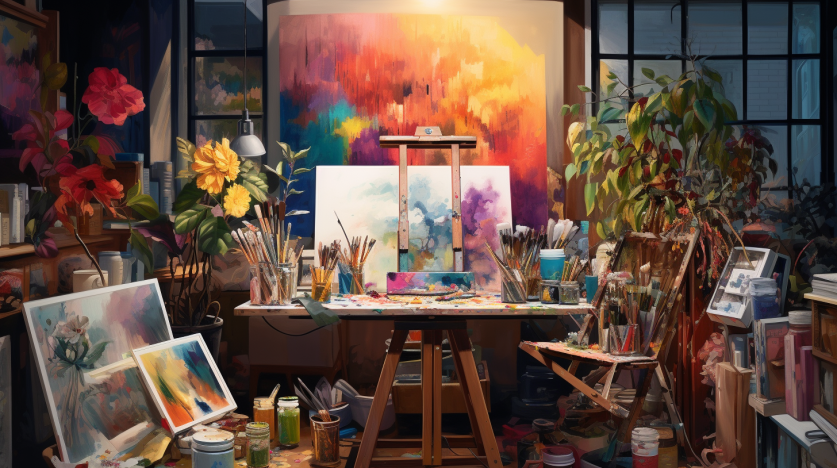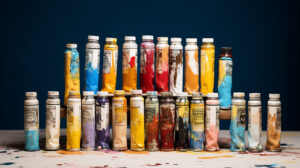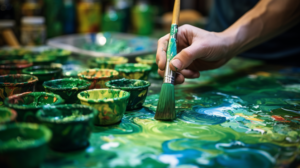
Comparing Techniques: Watercolors Versus Other Mediums
You’re about to dive into the vibrant world of art mediums, specifically, watercolors. You’ll explore their unique characteristics and compare them to oils and acrylics.
Don’t worry if you’re undecided on your preferred medium, we’ve got you covered. By the end, you’ll have a deeper understanding that’ll help you choose your artistic path.
Get ready to unleash your creativity, because it’s time to paint your world with knowledge!
Understanding Artistic Mediums
Before you can fully appreciate the differences between watercolors and other artistic mediums, it’s essential to understand what an artistic medium is in the first place. It’s more than just a tool or material—it’s a language through which an artist communicates their vision.
Now, look at digital art exploration. Here, the medium is digital technology, offering unlimited possibilities for creativity. It’s a stark contrast to watercolors, where your canvas and paints set certain limits.
Then, there’s the pastel usage basics. Pastels are about texture and depth, quite different from the fluidity of watercolors.
Each medium gives you a unique dialogue with your creativity. Mastering a medium isn’t just about technique, it’s about understanding its distinct language.
Watercolor Techniques Explored
In comparison to other art mediums, you’ll find that mastering watercolor techniques hinges on understanding the interaction between water, pigment, and paper. This interaction can be manipulated in several ways to create distinct effects:
- Color Mixing Techniques: You can create a myriad of hues by blending different pigments. This is done either on the palette before application or directly on the paper for a more spontaneous effect.
- Wet on Wet Approach: This technique involves applying wet paint onto a wet surface. It results in soft, diffused edges and interesting color bleeds, adding a dreamy quality to your artwork.
- Layering: This involves applying multiple thin layers of paint, allowing each to dry before adding the next. This technique offers control over color intensity and depth.
Comparing Watercolors and Oils
Despite the similarities, when you compare watercolors and oils, you’ll notice significant differences in their application, drying time, and overall effect.
Oil paints, for instance, take longer to dry, allowing you to blend colors on the canvas. This enhances the color vibrancy, giving oils a richer, denser quality.
On the other hand, watercolors are quicker to dry, making them perfect for fast, spontaneous work. Yet, they’re more translucent, offering a subtler color expression.
The oil durability is another point to consider. Oil paints resist fading, ensuring your artwork lasts for generations. Watercolors, despite their delicate charm, can’t compete in this aspect. They’re more susceptible to light damage, necessitating proper care and preservation.
Acrylics Versus Watercolors
While you may find the quick-drying nature of watercolors appealing, you’ll discover that acrylics, too, offer this advantage, yet they bring a different set of characteristics to your canvas.
- Acrylic Flexibility
- Unlike watercolors, acrylics are highly versatile. You can thin them to mimic watercolor effects or apply them heavily for an oil-like texture.
- Drying Time Differences
- Both mediums dry quickly, but acrylics dry permanently. Watercolors, on the other hand, can be reactivated with water.
- Color Vibrancy
- Acrylics tend to have a stronger color intensity than watercolors and remain vibrant even when dry.
Analyzing these aspects, you’ll notice that choosing between acrylics and watercolors isn’t simply about drying time or flexibility, but also about the visual impact and permanence you desire in your artwork.
Choosing Your Preferred Medium
You’ve explored the characteristics of watercolors and acrylics, now it’s time to decide which medium best suits your artistic vision and style.
Consider medium affordability. While acrylics might offer bold, vibrant colors, they can be more costly than watercolors. On the other hand, watercolors, being more affordable, allow for a broader exploration of personal style without stretching your budget.
In your personal style exploration, remember that each medium presents unique textures and effects. Watercolors lend themselves to a more fluid, delicate style, while acrylics can achieve heavier, more defined lines. It’s crucial to experiment with both, observing how they interact with your creative impulses.
Ultimately, the choice of medium should enhance your artistry, not limit it.
Frequently Asked Questions
How Can I Preserve My Watercolor Artwork for a Long Period of Time?
To preserve your watercolor art, you’ll want to use framing techniques with UV protection methods. Use acid-free matting and UV-protective glass; this’ll shield your artwork from harmful light, keeping it vibrant over time.
Are There Any Specific Brushes Recommended for Watercolor Painting?
Yes, brush choice matters in watercolor painting. Choose vegan brushes for eco-friendliness. Synthetic brushes hold water well, perfect for watercolors. Don’t forget proper brush cleaning techniques to extend their life and maintain quality.
What Are Some Common Mistakes Beginners Make When Using Watercolors?
You’re often overlooking color mixing basics and watercolor paper selection. It’s crucial not to muddy your colors and choose the right paper to maintain vibrancy. These common missteps can dull your watercolor paintings.
Are There Any Health Concerns Associated With Using Watercolors or Other Artistic Mediums?
You’re right to consider health concerns. While watercolors have low toxicity levels, other mediums like oils can be hazardous. It’s crucial to follow safe practices, like using adequate ventilation and protective gear.
How Can I Incorporate Digital Tools in My Watercolor Painting Process?
You can incorporate digital tools in your watercolor process by using software like Photoshop for digital blending. It’s a great way to combine the fluidity of watercolors with the precision of digital art.
In conclusion, you’ve explored the intricate world of artistic mediums, delving into the specifics of watercolors, oils, and acrylics. Each possesses unique qualities, from the fluid transparency of watercolors to the rich texture of oils and the versatility of acrylics.
Your artistic journey is a personal one, and the medium you choose should resonate with your vision and style. Remember, there’s no right or wrong, only what speaks to you and helps you express your creativity.



